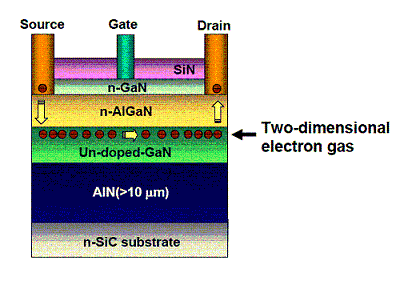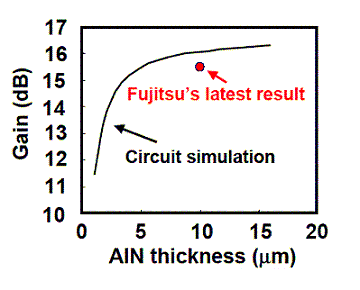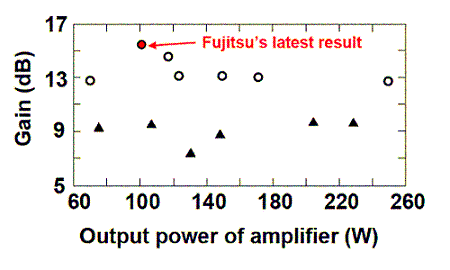Archived content
NOTE: this is an archived page and the content is likely to be out of date.
Fujitsu Develops Breakthrough Technology for Low-Cost Production of Gallium-Nitride HEMT
- Reduces production costs to less than 1/3 -
Fujitsu Laboratories Ltd.
-
[1] gallium-nitride (GaN)
A type of wide band-gap semiconductor that is more resistant to breakdown at a given voltage than conventional semiconductors, such as gallium arsenide and silicon.
-
[2] high electron mobility transistors (HEMT)
A field-effect transistor that takes advantage of operation of the electron layer at the boundary between different semiconductor materials that is relatively rapid compared to that within conventional semiconductors. Fujitsu led the industry with its development of HEMT technology in 1980, and the technology now underpins much of today's fundamental IT infrastructure, including satellite transceivers, wireless equipment, GPS-based navigation systems, and broadband wireless networking systems.
-
[3] distortion compensation circuits
Fujitsu's distortion compensation technology is based on the Digital Pre-Distortion (DPD) method, which adds compensatory characteristics to the signal before distortion occurs. Fujitsu has incorporated this technology into a distortion-compensation chip.
-
[4] low-cost conductive SiC substrates
Low resistance SiC substrate that is easy to produce, thereby resulting in low cost compared with S.I. SiC substrate.
-
[5] parasitic capacitance
Capacitance that does not result from a device's active region during operation. When using a conductive substrate, capacitance may occur between the substrate and an electrical contact. Because this parasitic capacitance can degrade high-frequency characteristics, it is mandatory that parasitic capacitance be minimized.
-
[6] gain
The ratio between an input signal and output signal in an amplifier, indicating the conversion efficiency of output power as input power.
-
[7] hydride vapor phase epitaxy
A high-temperature method of forming an epitaxial layer that uses aluminum chloride and ammonia as source materials. Epitaxial AlN layers were grown using aluminum-chloride and ammonia at a high temperature.
-
[8] metal organic vapor phase epitaxy
A high-temperature method of forming an epitaxial layer that uses alkyl-aluminum, alkyl-gallium, and ammonia as source materials.
-
[9] band gap
The energy band in which electrons in a semiconductor crystal cannot exist. Because atoms in a semiconductor crystal are adjacent, their action on one another causes electrons to pass energy continuously. However, an energy band (the band gap) can be formed such that electrons cannot occupy that state in the passage of energy. Semiconductors for which this band gap is large are known as wide band-gap semiconductors.
-
[10] maximum power-added efficiency
A ratio indicating the conversion efficiency of direct current as an output signal supplied to an amplifier, converted to high-frequency power.
About Fujitsu Laboratories Ltd.
Founded in 1968 as a wholly owned subsidiary of Fujitsu Limited, Fujitsu Laboratories Limited is one of the premier research centers in the world. With a global network of laboratories in Japan, China, the United States and Europe, the organization conducts a wide range of basic and applied research in the areas of Multimedia, Personal Systems, Networks, Peripherals, Advanced Materials and Electronic Devices.
For more information, please see: http://www.labs.fujitsu.com/en/
Technical Contacts
Photonics and Electronics LaboratoriesHigh-Speed IC Technologies Lab.
![]() Phone: +81-46-250-8243
Phone: +81-46-250-8243
![]() E-mail: gan@ml.labs.fujitsu.com
E-mail: gan@ml.labs.fujitsu.com
Company:Fujitsu Laboratories Ltd.
Date: 21 December, 2004
City: Tokyo
Company:
Fujitsu Laboratories Ltd.,
,
,
,
,


